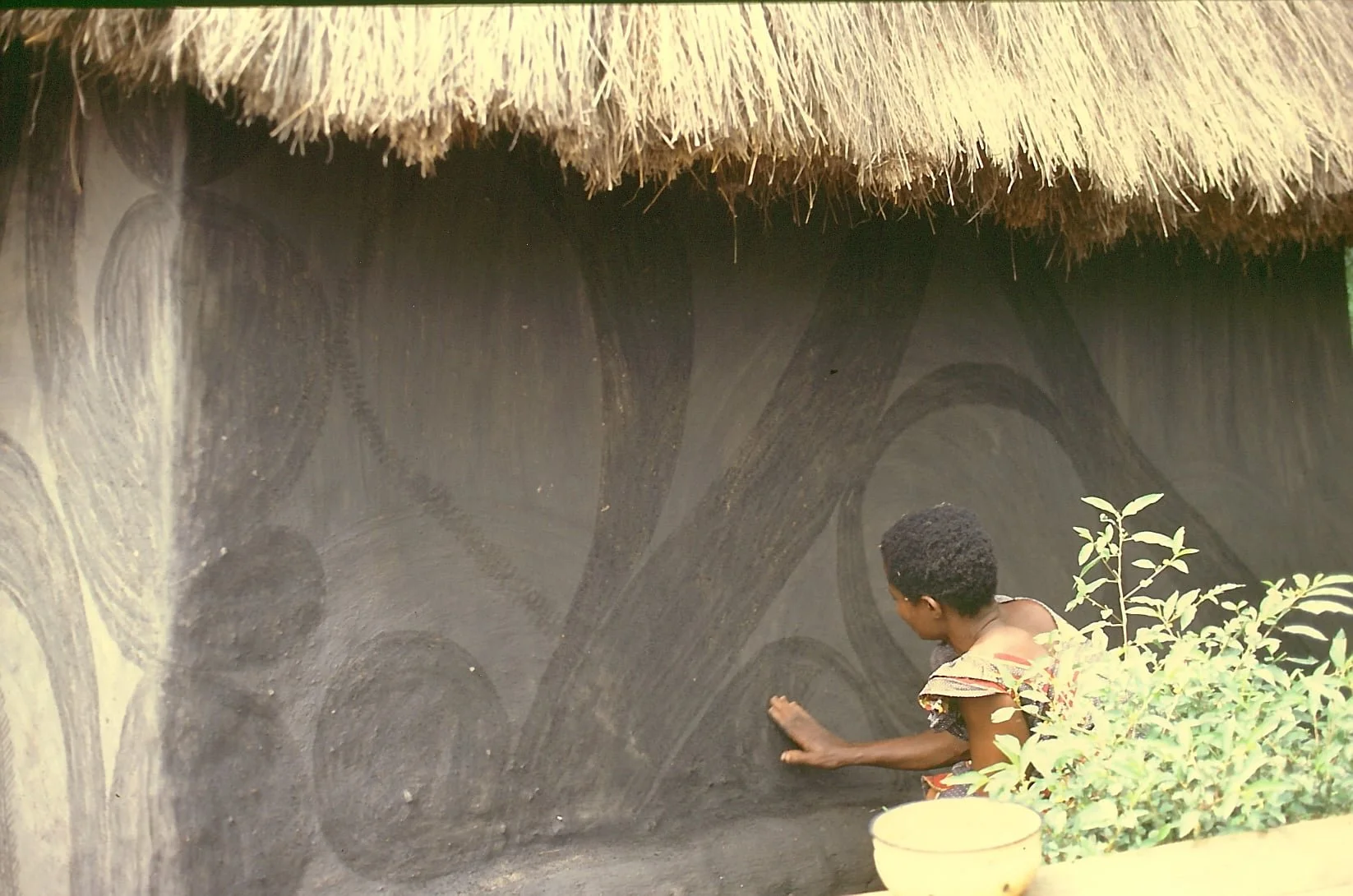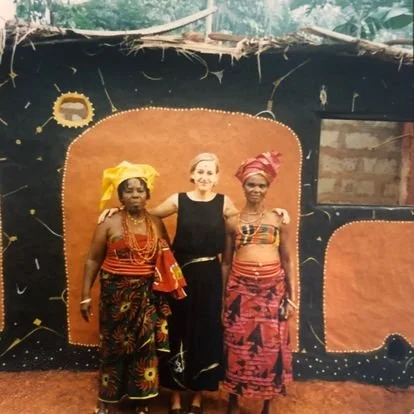Improv and the Art of UX Research
One thing I have learned from my strange career is that with enough experience you can improvise around the rules with deeply powerful results.
As a nineteen year old on a study abroad program in Nigeria, I spent a month doing research on what would later become my doctoral thesis project--body and mural painting in southeastern Nigeria. I was on my path to becoming an African art historian. I had taken classes on how to do field research, read books, talked to experienced field researchers, I felt very prepared.
During that month I followed the rules, took pictures, careful notes, conducted interviews just so, and tried to maintain the line between researcher and subject.
Helen Obiora, artist from Omo in Nigeria, painting on a building in her compound.
When I returned to Nigeria after graduation for a Fulbright year, I spent months at a time doing this same type of research. I became experienced. I remember chatting with my advisor at the University of Nigeria Nsukka campus one evening about a recent stint with some artists in a nearby village. I talked about what I had learned, went over my notes. He was an artist, a generous listener, the most thoughtful and brilliant person I worked with during my first career. When I could tell when he had something important to say, and I would grow quiet to give him space.
“At some point,” he said gently, “you are going to have to put down the camera, the video, the notes, and work alongside these women. It’s the only way you are really going to understand these women and their art.”
My gut reaction was immediate. How could he be right? His suggestion violated every rule I had learned about field research. I was the studier, not the studied. What if something important happened and I didn’t write it down and then forgot?
I kept my worries to myself and trusted him. And he was right. By breaking every field research rule I ended up understanding this art form in a totally new, deeper way. I understood the feel of the materials, how hard it was to grind up certain pigments, how you need thick callouses on your hands to work on a clay wall, how satisfying it is to repair and smooth a wall before painting. I learned what it felt like to paint with a community of women. My understanding of Igbo language also increased dramatically as the artists ordered me around, telling me where to paint, what I had done wrong, to go get more water, grind up more yellow pigment. I made up my process as I went along, writing up notes and follow up questions at the end of the day, sketching things I remembered. I realize now I didn’t need to write anything, though, because my understanding of this art had become so deep. It lived in my whole body, not just my mind. I made it up, I improvised, and it worked.
I fall back on that improvisational experience frequently in my new career.
Rita Okafor, me, Ekdinma Ojiakor in front of a wall we painted together in Agulu, Nigeria.
Design Team's Arc Week Design Jam Extravaganza
Arc XP’s annual Arc Week, where the whole company comes together at the Washington Post offices, gave me my most recent chance to improvise. Two days before the official program began, the design team met for a “Design Jam” focused on one of our products. l admit, we also were looking forward to just hanging out, for some of us it was the first time we met in person! Like my experience in Nigeria, that real life interaction in DC, eating meals together, walking to get coffee, everyone unmuted all at once (!) helped me understand my team members at a deeper level.
New Product for Senior Designers
We had two designers in the process of onboarding to the product on which we intended to focus. As a group we were all rallying around their onboarding, working to master both the history and the general ins and outs of the product. It was great to get some fresh eyes on this product, and the transition really brought us together as a team.
As we all learned more about this product, some common questions and concerns arose. This product is an incredibly complex tool, possibly the most complex product in our suite of products, with lots of different elements of functionality. It has a healthy group of power users who all know exactly where everything is and how it works, but for new folks learning the tool it can be very intimidating. In our research repository, the product name is regularly tagged with “fear.”
Super Sleuth Designer
As we talked about what it might look like to come together as a team for a Design Jam focused this complex product, one of our super sleuth designers did some poking around in drop box and found that just such a design jam had already been done--two years ago!
I worked with this designer to pull together the artifacts from that design jam, and we marveled over the fact that many of the concerns raised in that design jam were still relevant two years later. They were the same concerns and questions we were raising as a team. While some of those earlier concerns had been addressed, other still hung there, just waiting for us to take them on.
An Improvisational Design Jam: Homework Fail Edition
As a recovering Professor, of course my instinct upon digging through the earlier design jam materials was to assign everyone homework for over the weekend (I know, I know, what was I thinking, but bear with me!)
Here was my assigned reading:
Reading/Learning Assignment for Monday (Feel free to add anything you find relevant!):
Review Miro Board
Read summary document for previous design sprint
Review Product Manager’s Knowledge Share PDF
Review Product Manager’s Competitive Analysis
Additional Resources if you are interested:
Search our research repository for product name
Look through client feedback documents from Product Manager
I am sure you are shocked to learn that when we met on Monday no one had done the homework. Many were unaware that I had assigned homework, others people told me their ferret had eaten their homework…you get the idea. I may have overshot the mark. Maybe.
Alas, not doing the homework turned out to be a great move on the designers' part. It pushed me to improvise with the group, and we ended up sifting through the material together on Monday. The process inspired expansive conversations, important questions, and more learning.
The Product Manager joined us as we learned, answering questions, demonstrating user flows, and talking about target personas. We were also able to get our VP of Product and Technology to join us, and he shared the history and the future vision for the product. His high level and depth of time views were essential to understanding the product in the most comprehensive way possible.
Now the design team had a rich foundation of shared knowledge from which to move forward.
How Might We Dot Voting
We could have just done a straightforward Google Sprint, as the design team has done countless times in the past. But such an approach felt somehow unnecessarily artificial and constrained--instead we just improvised. The team discussed major themes from the previous design jam, from our talks with the PM and the VP of Product and Technology, and I wrote these themes down on a dry erase board as we talked. I used these themes to come up with a few How Might We Statements. Other designers grabbed pens and came up to write their own statements. We edited them down, we saw where they overlapped and combined ideas as needed. After about an hour or so this very organic collaboration, we voted on where we wanted to focus our time. We then broke up into two groups of designers to ideate on designs that addressed the How Might We question.


